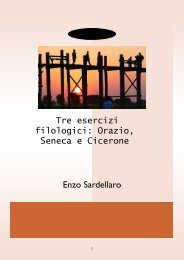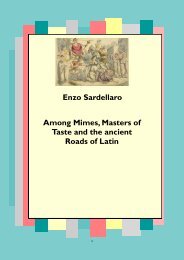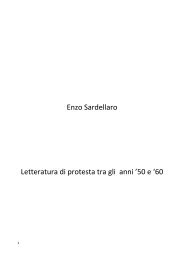Three Studies on the Ancient World
I have collected in this e-book some essays written at different times on Crete that is in various aspects related to the legend of Atlantis, on the first inhabitants of America, and on Black Lake, Saskatchewan. The first inhabitants of this region were Proto-Indians hunters arriving from the North and seeking new hunting grounds.
I have collected in this e-book some essays written at different times on Crete that is in various aspects related to the legend of Atlantis, on the first inhabitants of America, and on Black Lake, Saskatchewan. The first inhabitants of this region were Proto-Indians hunters arriving from the North and seeking new hunting grounds.
Create successful ePaper yourself
Turn your PDF publications into a flip-book with our unique Google optimized e-Paper software.
<str<strong>on</strong>g>Three</str<strong>on</strong>g> <str<strong>on</strong>g>Studies</str<strong>on</strong>g> <strong>on</strong> <strong>the</strong><br />
<strong>Ancient</strong> <strong>World</strong>: Atlantis,<br />
America, Canada<br />
Enzo Sardellaro<br />
1
C<strong>on</strong>tents<br />
Between <strong>the</strong> Palace of Knossos and Atlantis<br />
Sources<br />
White Men in America before Columbus<br />
Sources<br />
North American Paleo-Indians nomadic<br />
hunters<br />
R.S. MacNeish and <strong>the</strong> first archaeological excavati<strong>on</strong>s<br />
Arthur Moffat’s expediti<strong>on</strong><br />
Primitive prehistoric settlements in <strong>the</strong> Black Lake area<br />
The frequenters of <strong>the</strong>se outposts were hunters<br />
Arctic Paleo-Eskimo groups of hunters<br />
Sources<br />
2
Between <strong>the</strong> Palace of Knossos and<br />
Atlantis<br />
The territory of Crete, located in <strong>the</strong> Eastern Mediterranean Sea,<br />
South of <strong>the</strong> Cyclades, is dominated by mountainous terrain, but<br />
it also offers beautiful beaches, enjoying a mild climate throughout<br />
<strong>the</strong> year. In about three-quarters of an hour, a pretty road<br />
will lead you out of <strong>the</strong> town of Candia towards <strong>the</strong> site of <strong>the</strong><br />
ancient city of Knossos. You will pass throughout vineyards and<br />
olive groves, while <strong>the</strong> mighty Mount Jouktas was always in fr<strong>on</strong>t<br />
of you, where you will see clearly <strong>the</strong> remains of <strong>the</strong> sanctuary of<br />
Zeus, where, according to legend, <strong>the</strong>re is <strong>the</strong> tomb of <strong>the</strong> King of<br />
<strong>the</strong> gods. You will glance around <strong>the</strong> side of <strong>the</strong> road and will<br />
see <strong>the</strong> ruins of <strong>the</strong> ancient Roman “Col<strong>on</strong>ia Julia Nobilis Cnosus”<br />
(27 BC). A few steps bey<strong>on</strong>d <strong>the</strong> Roman ruins, <strong>the</strong> Palace of<br />
Knossos, situated <strong>on</strong> and around <strong>the</strong> Kephala Hill, and near <strong>the</strong><br />
Keratos river, was before your eyes.<br />
3
The Palace of Knossos has <strong>the</strong> shape of a quadrilateral, with a rectangular<br />
courtyard area in <strong>the</strong> middle, crossed at right angles by<br />
two main lines that follow <strong>the</strong> orientati<strong>on</strong> to <strong>the</strong> cardinal directi<strong>on</strong>s.<br />
Perhaps we find here <strong>the</strong> typical layout of <strong>the</strong> Roman camp, where<br />
<strong>the</strong> main street running north-south was <strong>the</strong> cardo, which is<br />
crossed by streets that run east-west (<strong>the</strong> decumanus). The Cretan<br />
Palace had no fortificati<strong>on</strong>s, but <strong>on</strong> all sides was closed by powerful<br />
walls, of which <strong>the</strong> Western <strong>on</strong>e is well preserved. On <strong>the</strong> North<br />
<strong>the</strong>re are a few rooms <strong>on</strong>ce c<strong>on</strong>taining thousands of clay tablets,<br />
locked in crates marked with a seal. Tablets showed a hieroglyphic<br />
writing system never seen before, c<strong>on</strong>taining <strong>the</strong> inventory of <strong>the</strong><br />
Royal administrati<strong>on</strong> of Knossos. On <strong>the</strong> walls of <strong>the</strong> thr<strong>on</strong>e room<br />
large painted figures of griffins and plants are still visible, while a<br />
great staircase of four ramps down to <strong>the</strong> courtyard, surrounded <strong>on</strong><br />
two sides by porticos, with a balustrade adorned with columns and<br />
pilasters. The Northwest Palace of Knossos shows wide terraces<br />
from which <strong>the</strong> citizens of Knossos were able to watch games, religious<br />
functi<strong>on</strong>s, and ritual dances in h<strong>on</strong>or of <strong>the</strong> Great Goddess.<br />
4
We can find <strong>the</strong> period of greatest development of Minoan civilizati<strong>on</strong><br />
between 1700 and 1613 BC, when <strong>the</strong> island came into commercial<br />
and cultural c<strong>on</strong>tacts not <strong>on</strong>ly with <strong>the</strong> Achaeans but also<br />
with Egypt. The foreign trade was <strong>on</strong>e of <strong>the</strong> fundamental aspects<br />
of <strong>the</strong> Minoan ec<strong>on</strong>omy and society, so that, Sir Arthur Evans, basing<br />
himself <strong>on</strong> Thucydides, spoke of a Minoan thalassocracy.<br />
(Evans, 1921. I. 10). But no less significant, were agriculture and<br />
pastoralism as a source of wealth.<br />
We comm<strong>on</strong>ly ignore <strong>the</strong> details of Minoan political structure, but<br />
it seems established that <strong>the</strong> great palaces were mostly built as luxurious<br />
residences of <strong>the</strong> Kings (called Minos), priests and court officials,<br />
who had managed to surround <strong>the</strong>mselves with every comfort<br />
and c<strong>on</strong>venience. The whole historiography <strong>on</strong> Crete agrees that <strong>the</strong><br />
absence of fortificati<strong>on</strong>s is <strong>the</strong> proof of <strong>the</strong> pacific character of <strong>the</strong><br />
ancient Cretan society.<br />
But it was about <strong>on</strong>e particular point that Evans’ works fascinated<br />
people all over <strong>the</strong> world, namely, <strong>the</strong> disappearance of <strong>the</strong> great<br />
Cretan civilizati<strong>on</strong>. Around <strong>the</strong> seventeenth century BC a cataclysmic<br />
event (Friedrich, 2013,39), perhaps a massive earthquake,<br />
caused by <strong>the</strong> erupti<strong>on</strong> of <strong>the</strong> volcano of Santorini island, destroyed<br />
all <strong>the</strong> buildings in it, <strong>the</strong>reby ending <strong>the</strong> Cretan civilizati<strong>on</strong>. The fact<br />
is that, <strong>the</strong> entire area was pr<strong>on</strong>e to volcanic explosi<strong>on</strong>s and c<strong>on</strong>sequent<br />
destructive earthquakes. Santorini was literally destroyed, and<br />
<strong>the</strong> entire center of <strong>the</strong> island exploded. When <strong>the</strong> sea water poured<br />
inside <strong>the</strong> crater, huge explosi<strong>on</strong>s occurred, and tidal waves propagated<br />
throughout <strong>the</strong> entire archipelago , ravaging villages and palaces<br />
in Crete.<br />
5
Even if “It is unlikely, however, that <strong>the</strong> palace of Knossos was destroyed<br />
by tsunamis, because it has an elevati<strong>on</strong> of about 60 m<br />
above <strong>the</strong> sea ” (Friedrich, 2013. 46), <strong>the</strong> Cretans lost <strong>the</strong>ir political<br />
independence, because of <strong>the</strong> attack which was brought to <strong>the</strong> island<br />
by <strong>the</strong> Achaeans of Mycenae, who came into c<strong>on</strong>flict with<br />
Crete because of <strong>the</strong> wool trade.<br />
As Rodney Castleden stated, “The Minoans became rich <strong>on</strong> <strong>the</strong> back<br />
of large scale wool producti<strong>on</strong> *…+ and <strong>the</strong> Mycenaean kings and<br />
<strong>the</strong>ir merchants were able to exploit <strong>the</strong> fall of Knossos” (Castleden,<br />
2005. 189, 195). Thus <strong>the</strong> Achaeans of Mycenae “were not <strong>the</strong><br />
cause” of <strong>the</strong> devastati<strong>on</strong> suffered by Crete in <strong>the</strong> seventeenth century<br />
BC, as it was thought by several historians over forty years ago,<br />
but “<strong>the</strong> c<strong>on</strong>sequence,” because <strong>the</strong> Achaeans probably took advantage<br />
of <strong>the</strong> weakness of <strong>the</strong> Cretans, troubled by an insurmountable<br />
calamity, to seize <strong>the</strong> island, and inserting it into <strong>the</strong> Mycenaean<br />
power system.<br />
But <strong>the</strong> disaster that engulfed Crete is in various aspects related to<br />
<strong>the</strong> legend of Atlantis, which was narrated by Plato (Timaeus).<br />
Critias and Timaeus learned <strong>the</strong> story of Atlantis from Sol<strong>on</strong>, who<br />
had stayed some while at Sais, in <strong>the</strong> Nile Delta, where a priest had<br />
told him about Atlantis. According to Plato, Atlantis was located “in<br />
<strong>the</strong> Atlantic Ocean.” Now, I perceive that to enter into discussi<strong>on</strong> <strong>on</strong><br />
Atlantis I am going to stir up a hornet's nest, but hundreds of hypo<strong>the</strong>ses<br />
stay firmly in <strong>the</strong> realm of fantasy.<br />
6
Somebody has taken a poetical image used by Plato as “<strong>the</strong> objective<br />
reality.” When Plato spoke of “Atlantic Ocean, ” he meant<br />
simply to refer to an immense body of water “governed” by <strong>the</strong> god<br />
Atlas. “The old Homeric noti<strong>on</strong> of <strong>the</strong> river Ocean retained its place<br />
in <strong>the</strong> poets l<strong>on</strong>g after its meaning had been aband<strong>on</strong>ed; and some<br />
indicati<strong>on</strong>s are found of an attempt to rec<strong>on</strong>cile it with later discoveries,<br />
by placing <strong>the</strong> Ocean outside of all seat of <strong>the</strong> world even of<br />
<strong>the</strong> outer seas. Afterwards, <strong>the</strong> language of old poets was adapted<br />
to <strong>the</strong> progress of knowledge by transferring <strong>the</strong> poetical name of all<br />
-encircling river to <strong>the</strong> sea which was supposed (by most geographers<br />
though not by all) to surround <strong>the</strong> inhabited world; and this<br />
encircling sea was called not <strong>on</strong>ly Ocean, but also by <strong>the</strong> specific<br />
names applied to <strong>the</strong> Atlantic Ocean.<br />
Thus, in <strong>the</strong> work de Mundo falsely ascribed to Aristotle it is said<br />
that <strong>the</strong> whole world is an island surrounded by <strong>the</strong> Atlantic Sea *…+<br />
The same idea is again and again repeated in passages of <strong>the</strong> work,<br />
where <strong>the</strong> name used is simply Okeanòs.” (Smith, 1872. I. 312). It<br />
suffices to say that <strong>the</strong> Greeks called even <strong>the</strong> Nile Oceanus: “ Herodotus<br />
observed that Homer called <strong>the</strong> Nile Okeanòs,<br />
(=Oceanus).” ( Holmes Agnew, 1844. 123). But <strong>the</strong>re are o<strong>the</strong>r assumpti<strong>on</strong>s<br />
which are relevant, just as <strong>the</strong> belief that Santorini was<br />
<strong>the</strong> locati<strong>on</strong> of Atlantis. Before J.V. Luce’s essay, which identified Atlantis<br />
with Santorini island, in 1969, Edwin Swift Balch has c<strong>on</strong>vincingly<br />
argued that <strong>the</strong> island of Santorini could be Atlantis.<br />
7
“Did <strong>the</strong> Egyptians or <strong>the</strong> Greeks o in <strong>the</strong> years 600 BC have any<br />
knowledge of <strong>the</strong> Atlantic Ocean? There is no record of anything of<br />
<strong>the</strong> kind .” (Swift Balch, 1917. 3. 391). Balch was right, because<br />
after all <strong>the</strong> Greeks knew almost nothing of Europe, “Nor were <strong>the</strong>y<br />
better acquainted with <strong>the</strong> Nor<strong>the</strong>rn Ocean; *…+ <strong>the</strong> Greeks knew<br />
nothing of <strong>the</strong> extreme parts of Europe nor of *…+ <strong>the</strong> Nor<strong>the</strong>rn<br />
coasts of Germany <strong>on</strong> <strong>the</strong> Baltic and <strong>the</strong> British Isles. ” (Borlase,<br />
1769. 32).<br />
In his turn, J. V. Luce stated that, “ One has to admit that <strong>the</strong> c<strong>on</strong>vergence<br />
of archaeology and Greek literary traditi<strong>on</strong> about this site<br />
has become very close.” (Luce, 1969. 14). Despite many refusals,<br />
Balch and Luce’s hypo<strong>the</strong>ses are not fanciful, and above all <strong>the</strong>y are<br />
<strong>the</strong> <strong>on</strong>ly <strong>on</strong>es that had respected <strong>the</strong> state of <strong>the</strong> Greek’s geographical<br />
knowledge. As Balch said clearly, “Is <strong>the</strong>re any recollecti<strong>on</strong><br />
of Crete and its destructi<strong>on</strong> in Greek records? It seems as if<br />
<strong>the</strong>re were in <strong>the</strong> shape of <strong>the</strong> legendary Minotaur *…+ And <strong>the</strong><br />
Minotaur, Greek mythology tells us, was destroyed by Theseus,<br />
which would seem to be a reminiscence of <strong>the</strong> destructi<strong>on</strong> of Minoan<br />
Crete by A<strong>the</strong>nians and Egyptians.” (Swift Balch, 1917. 3. 390).<br />
The system of knowledge of <strong>the</strong> ancient Greeks should be respected<br />
if we wish to obtain some plausible soluti<strong>on</strong>s, especially because<br />
Plato is “our <strong>on</strong>ly authority for <strong>the</strong> story.” (Guthrie, 1978.<br />
248).<br />
8
In c<strong>on</strong>clusi<strong>on</strong>, if Knossos has become an extraordinary reality, <strong>the</strong><br />
hypo<strong>the</strong>sis about Santorini seems to me perhaps not reliable or<br />
unreliable in any absolute sense, but certainly it has more points of<br />
c<strong>on</strong>tact with Greek culture than several hundreds of proposals that<br />
seem to rest <strong>on</strong> <strong>the</strong> “endless Ocean of fantasies.”<br />
9
Sources<br />
Baker J.A. 1995. Cheque Mate: The Game of Princes . Whitaker<br />
House.<br />
Borlase, W. 1769. Antiquities, Historical and M<strong>on</strong>umental, of <strong>the</strong><br />
County of Cornwall. L<strong>on</strong>d<strong>on</strong>.<br />
Castleden, R. 2005. The Mycenaeans. L<strong>on</strong>d<strong>on</strong> and New York:<br />
Routledge.<br />
Evans, J. A. 1921. The Palace of Minos at Knossos. L<strong>on</strong>d<strong>on</strong>: MacMillan<br />
and Co., Limited.<br />
Friedrich, W. L. 2013. “The Minoan Erupti<strong>on</strong> of Santorini Around<br />
1613 BC and Its C<strong>on</strong>sequences”. Tagungen des Landesmuseums für<br />
Vorgeschichte. Halle. Band 9. 44. “ A. Evans began to speculate about<br />
a possible c<strong>on</strong>necti<strong>on</strong> between <strong>the</strong> erupti<strong>on</strong> of Santorini and <strong>the</strong> destructi<strong>on</strong><br />
of Knossos. ” Link: http://geo.au.dk/fileadmin/<br />
www.geo.au.dk/02_Forskning/Publikati<strong>on</strong>er/friedrich_satz.pdf<br />
Guthrie, W. K. C. 1978. A History of Greek Philosophy. The Later Plato<br />
and <strong>the</strong> Academy. Cambridge University Press.<br />
Holmes Agnew, J. 1844. The Eclectic Magazine of Foreign Literature,<br />
Science, and Art. New York & Philadelphia: Leawitt, Trow & Co.<br />
Luce, J. V. 1969. Lost Atlantis: New Light <strong>on</strong> an Old Legend. McGraw-<br />
Hill.<br />
Smith, W. 1872. A Dicti<strong>on</strong>ary of Greek and Roman Geography. L<strong>on</strong>d<strong>on</strong>:<br />
J. Murray.<br />
Swift Balch, E. 1917. “Atlantis or Minoan Crete”. Geographical Review.<br />
3. Link: http://www.jstor.org/stable/207382.<br />
10
White Men in America before Columbus<br />
In <strong>the</strong> early Middle Ages, some white men pushed toward Florida,<br />
<strong>the</strong> Carolinas, Georgia and Vinland. Here <strong>the</strong>y settled, establishing<br />
<strong>the</strong> first group of white men in America.<br />
A very interesting study published by <strong>the</strong> prestigious Royal Society<br />
of Nor<strong>the</strong>rn Antiquaries in 1839 (founded by Professor C. Christian<br />
Rafn) , gave us some valuable informati<strong>on</strong> based <strong>on</strong> C. Christian<br />
Rafn’s primary research work <strong>on</strong> <strong>the</strong> first inhabitants of America.<br />
Compiled from au<strong>the</strong>ntic documents and <strong>the</strong> most accurate<br />
sources of informati<strong>on</strong>, Professor Rafn stated that <strong>the</strong> Skrelinghi or<br />
Old Eskimos (from <strong>the</strong> Danish word Skvelling, little men) lived in<br />
more sou<strong>the</strong>rn countries than today.”<br />
These facts are supported both by <strong>the</strong> most ancient written documents<br />
and manuscripts dating back to <strong>the</strong> tenth century, and by<br />
human remains found during archaeological excavati<strong>on</strong> <strong>on</strong> site.<br />
According to Professor Rafn, some ancient Northmen discovered<br />
<strong>the</strong> eastern coasts of North America, where <strong>the</strong>y attempted to establish<br />
col<strong>on</strong>ies in Massachusetts and Rhode Island. They discovered<br />
three lands, called respectively Helluland, Markland and Vinland,<br />
which it appears to have extended as far as Massachusetts<br />
and Rhode Island.<br />
11
According to Professor Rafn, <strong>the</strong>re was ano<strong>the</strong>r vast land in fr<strong>on</strong>t of<br />
<strong>the</strong> country inhabited by <strong>the</strong> Skrelinghi, where, according to standard<br />
accounts of <strong>the</strong>ir history, a white populati<strong>on</strong> lived. These men<br />
were dressed in white raiment, and used l<strong>on</strong>g spears in which pieces<br />
of cloth were tied toge<strong>the</strong>r near <strong>the</strong> top, uttering dreadful cries<br />
at <strong>the</strong> same time. The ancient author of <strong>the</strong> document thought that<br />
it was <strong>the</strong> land called Hvitra-mann-a-land, that is, <strong>the</strong> White Man’s<br />
Land, also called Irland and Mikla, namely Great Ireland.<br />
This regi<strong>on</strong> probably must be regarded as bel<strong>on</strong>ging to North America<br />
which from <strong>the</strong> sou<strong>the</strong>rn shore of Ckesapeak Bay stretches towards<br />
<strong>the</strong> South, including <strong>the</strong> Carolinas, Georgia and Florida. A very<br />
interesting oral traditi<strong>on</strong> remains vital today am<strong>on</strong>g <strong>the</strong> indigenous<br />
peoples, in particular <strong>the</strong> Sciavannesi Shawannos, who emigrated<br />
from Florida during <strong>the</strong> 18th century to Ohio, where <strong>the</strong>y currently<br />
reside. According to <strong>the</strong>ir ancient traditi<strong>on</strong>s, Florida had <strong>on</strong>ce been<br />
inhabited by white people, who used ir<strong>on</strong> to make <strong>the</strong>ir tools. According<br />
to original documents, Florida had been <strong>the</strong> seat of a Christian<br />
col<strong>on</strong>y of Irishmen , who settled <strong>the</strong>re around 1000 AD, namely,<br />
during <strong>the</strong> Early Middle Ages.<br />
12
In fact, <strong>the</strong> powerful Chief Ari Marss<strong>on</strong>, from Reykianes in Iceland,<br />
had been trapped in lightning storms and pushed toward unknown<br />
lands by <strong>the</strong> force of wind in 985 AD. The first author of this report<br />
was <strong>the</strong> so called Navigator of Limerick (Hlymreksfari), a famous<br />
city of Ireland, where he had made a l<strong>on</strong>g stay. The learned and famous<br />
Ari Frodi, <strong>the</strong> oldest author of <strong>the</strong> Chr<strong>on</strong>icle of Landnama,<br />
said that his uncle, Thorkell Gellir or Gelliss<strong>on</strong>, a man worthy of<br />
credit, had heard several Icelanders tell of Thorfinnr Sigurdss<strong>on</strong><br />
Jarl, Earl of Orkney, who would often repeat that Ari Marss<strong>on</strong> was<br />
well known in Hvitra-mann-a-land, <strong>the</strong> White Man’s Land, who<br />
however couldn't get out of it, but that, n<strong>on</strong>e<strong>the</strong>less, he enjoyed<br />
<strong>the</strong> highest c<strong>on</strong>siderati<strong>on</strong> am<strong>on</strong>g this former people.<br />
Professor Rafn C<strong>on</strong>cluded his study, saying that all <strong>the</strong>se things<br />
clearly dem<strong>on</strong>strate that <strong>the</strong>re was a str<strong>on</strong>g relati<strong>on</strong>ship with <strong>the</strong><br />
Western lands, that is, <strong>the</strong> Orkney Islands, Iceland, and that very<br />
remote part of America in ancient times .<br />
Then Professor Rafn added that, after <strong>the</strong> year 1000 (probably in<br />
1004), <strong>the</strong>re were o<strong>the</strong>r expediti<strong>on</strong>s that followed those of <strong>the</strong><br />
oldest white men. A s<strong>on</strong> of Eric Thorvalds<strong>on</strong> called Leif was able<br />
to see two different lands already views by Biórn in 1002, to which<br />
he gave <strong>the</strong> names of Helluland (Land of bare rocks) and Markland<br />
(Wooded Land). After proceeding to <strong>the</strong> southward, Leif discovered<br />
a third land. Then he started to move westward, entering <strong>the</strong><br />
Gulf of Saint Lawrence, and at this latter place (Canada) he spent<br />
<strong>the</strong> winter.<br />
13
A German who accompanied Leif's expediti<strong>on</strong> found a type of grape,<br />
so <strong>the</strong> place was called Vinland, that is, <strong>the</strong> Land of Wine. This land<br />
later became very famous in <strong>the</strong> Annals of Scandinavia because<br />
many voyages had been made by o<strong>the</strong>r navigators, and especially by<br />
Thorvald, Leif’s bro<strong>the</strong>r, who founded <strong>the</strong>re a permanent col<strong>on</strong>y in<br />
1005, c<strong>on</strong>tinuing to explore neighboring lands that were those that<br />
surround and enclose <strong>the</strong> aforesaid Bay, i.e. <strong>the</strong> woodlands of Labrador,<br />
Canada, Terra Nova Islands, Anticosti Island (Quebec), Cape Bret<strong>on</strong>,<br />
New Brunswick, and Nova Scotia.<br />
14
Sources<br />
C. Cristiano Rafn, Memoria sulla scoperta dell’America nel X secolo<br />
a.C., Estratta dalle Memorie della Società Reale degli Antiquari del<br />
Norte, traduzi<strong>on</strong>e in italiano di Jacob Graberg, Pisa, Presso i fratelli<br />
Sistri, 1839, pp. 33-34. Rafn’s work was translated into English <strong>on</strong>e<br />
year before <strong>the</strong> Italian editi<strong>on</strong> of 1839, i.e. in MDCCCXXXVIII (1838)<br />
with <strong>the</strong> title, America discovered in <strong>the</strong> Tenth Century, by Charles<br />
C. Rafn, New York, William Jacks<strong>on</strong>, 102 Broadway, MDCCCXXXVIII<br />
*1838+. Besides, Rafn’s work was also translated in German, in <strong>the</strong><br />
same year, 1838, titled Die Entdeckung Americas im zehnten<br />
Jahrhundert. V<strong>on</strong> C. C. Rafn. Aus der dän. Hdschrift v<strong>on</strong> G. Mohnike,<br />
Stralsund, 1838.<br />
15
North American Paleo-Indians<br />
nomadic hunters<br />
Black Lake, Saskatchewan, is located at <strong>the</strong> eastern end of <strong>the</strong> Mackenzie<br />
basin, whose age is probably Precambrian. Later, this area became<br />
a privileged place for <strong>the</strong> migrati<strong>on</strong> of caribou. It was <strong>the</strong> main<br />
reas<strong>on</strong> for establishing temporary hunting settlements particularly<br />
in <strong>the</strong> area around Black Lake.<br />
R.S. MacNeish and <strong>the</strong> first archaeological excavati<strong>on</strong>s<br />
At first, archaeologists were interested in <strong>the</strong> geophysical aspects of<br />
Black Lake, Saskatchewan, namely <strong>the</strong> structure and compositi<strong>on</strong> of<br />
<strong>the</strong> soil, vegetati<strong>on</strong> and associated fauna, and some aspects of climate<br />
change scenarios. Later, an even more careful study came to a<br />
very interesting c<strong>on</strong>clusi<strong>on</strong> as a basis for understanding <strong>the</strong> development<br />
of human settlement and migrati<strong>on</strong> in this part of Black Lake.<br />
16
The first archaeological excavati<strong>on</strong>s in <strong>the</strong> area of <strong>the</strong> Black Lake,<br />
Saskatchewan, were carried out by R.S. MacNeish in 1949 and in<br />
1951. Born in 1917, MacNeish was a Golden Glove Boxing Champi<strong>on</strong><br />
out of New York. He was a pers<strong>on</strong> of great gusto, who in <strong>the</strong><br />
winter was to be found occasi<strong>on</strong>ally in Mexico, even while still<br />
heading up <strong>the</strong> Archaeological Secti<strong>on</strong> of <strong>the</strong> Nati<strong>on</strong>al Museum.<br />
In 1963, with Richard Forbis, he established <strong>the</strong> first Department<br />
of Archaeology in Canada at <strong>the</strong> University of Calgary, although<br />
in 1969 he left to join <strong>the</strong> Peabody Museum. He was, like his<br />
colleagues Emers<strong>on</strong> and Quimby, a graduate of <strong>the</strong> University<br />
of Chicago, short in stature, a hard driving character, and a devoted<br />
archaeologist.” (Daws<strong>on</strong>, 1999). R.S. MacNeish c<strong>on</strong>ducted a survey<br />
<strong>on</strong> behalf of <strong>the</strong> Nati<strong>on</strong>al Museum of Canada to define <strong>the</strong> boundaries<br />
of different cultural traditi<strong>on</strong>s <strong>on</strong> <strong>the</strong> shore of Lake Athabasca.<br />
In <strong>the</strong> course of his research, he also did a quick survey in <strong>the</strong><br />
Black Lake regi<strong>on</strong> (MacNeish, 1951). As Daws<strong>on</strong> said,<br />
“MacNeish ventured into <strong>the</strong> boreal forest when he was at <strong>the</strong> Nati<strong>on</strong>al<br />
Museum of Canada in <strong>the</strong> 1950s. In 1950, he excavated<br />
<strong>the</strong> first Palaeo-Indian site to be professi<strong>on</strong>ally investigated in<br />
Canada, <strong>the</strong> Brohm site, located <strong>on</strong> <strong>the</strong> shore of Lake Superior,<br />
<strong>on</strong> Thunder Bay opposite <strong>the</strong> city. He undertook surveys in<br />
<strong>the</strong> boreal forest in Manitoba, defining <strong>the</strong> cultural sequence al<strong>on</strong>g<br />
<strong>the</strong> Winnipeg River and in Saskatchewan at Lake Athabasca.”<br />
(Daws<strong>on</strong>, 1999).<br />
17
Arthur Moffat’s expediti<strong>on</strong><br />
Important archaeological soundings were also made under <strong>the</strong> directi<strong>on</strong><br />
of Arthur Moffat in 1955, starting from <strong>the</strong> Black Lake, and<br />
proceeding up Dubawnt-Thel<strong>on</strong> and Chipman rivers. But Arthur<br />
Moffat’s expediti<strong>on</strong>, and his epic canoe voyage had a tragic ending,<br />
“On July, 3, 1955, six men in three canoes showed into Black Lake,<br />
Saskatchewan, and began a l<strong>on</strong>g journey northward toward <strong>the</strong><br />
great Barren grounds *…+ In shooting rapids above Marjorie Lake two<br />
of three canoes capsized *…+ and Moffat succumbed.” (Helmer,<br />
1959).<br />
18
Primitive prehistoric settlements in <strong>the</strong> Black<br />
Lake area<br />
However, am<strong>on</strong>g all <strong>the</strong>se studies, <strong>on</strong>ly <strong>on</strong>e had explicitly addressed<br />
<strong>the</strong> problem of prehistoric settlements in <strong>the</strong> Black Lake regi<strong>on</strong>. The<br />
Prehistoric Occupati<strong>on</strong> of Black Lake Nor<strong>the</strong>rn Saskatchewan,<br />
1975, by Sheila J. Minni, was a milest<strong>on</strong>e in <strong>the</strong> field, because she<br />
was able to give a very credible account of primitive prehistoric<br />
settlements in <strong>the</strong> Black Lake area.<br />
Her survey revealed that <strong>the</strong> first inhabitants of this regi<strong>on</strong> were<br />
Proto-Indians hunters arriving from <strong>the</strong> North and seeking new<br />
hunting grounds. Minni’s research program involved a survey c<strong>on</strong>centrated<br />
<strong>on</strong> about sixty sites around Black Lake which were said<br />
to be not essentially related to a permanent settlement, but as a<br />
system of land observati<strong>on</strong> by temporary outposts. Archaeological<br />
data *arrow tips, and pointed knives+ have shown that indigenous<br />
peoples and different cultures overlapped each o<strong>the</strong>r in <strong>the</strong>se<br />
sites, because <strong>the</strong> peoples who lived <strong>the</strong>re practiced different lifestyles.<br />
19
The frequenters of <strong>the</strong>se outposts were<br />
hunters<br />
So that <strong>the</strong> frequenters of <strong>the</strong>se outposts were hunters, who followed<br />
migratory caribou herds throughout <strong>the</strong>ir dry-seas<strong>on</strong> migrati<strong>on</strong>s.<br />
From <strong>the</strong> early debates it emerged with some certainty<br />
that Paleo-Indians nomadic hunters frequented <strong>the</strong> Black Lake<br />
area, Saskatchewan, between <strong>the</strong> 7th Millennium BC and <strong>the</strong><br />
fifth millennium BC. O<strong>the</strong>r archaeological data, and additi<strong>on</strong>al<br />
lines of evidence refer to <strong>the</strong> sec<strong>on</strong>d millennium BC, because<br />
hunting tools bel<strong>on</strong>ging to <strong>the</strong> Indians Cree were found, while,<br />
between <strong>the</strong> 3rd century BC and <strong>the</strong> 2nd century AD, Chipewyan<br />
Indians * called pointed skins+ frequented <strong>the</strong> Black Lake area in<br />
spring and summer to hunt buffalo.<br />
20
Arctic Paleo-Eskimo groups of hunters<br />
Moreover, Arctic Paleo-Eskimo groups of hunters visited this area<br />
between <strong>the</strong> ninth and sixth centuries BC. “This data suggests a<br />
northward movement of late Paleo-Indian hunters from <strong>the</strong> plains<br />
through <strong>the</strong> boreal and transiti<strong>on</strong>al forests of <strong>the</strong> Canadian Shield.<br />
Gord<strong>on</strong> menti<strong>on</strong>s <strong>the</strong> possibility of nor<strong>the</strong>rly moving buffalo<br />
hunters shifting subsistence to <strong>the</strong> migratory barren-ground caribou<br />
in <strong>the</strong> wake of final deglaciati<strong>on</strong> in <strong>the</strong> barrenlands *…+ and a<br />
number of sources postulate that <strong>the</strong> caribou formed <strong>the</strong> subsistence<br />
base of <strong>the</strong>se Paleo-Indian hunters. It is possible that this<br />
postulate of barren-ground caribou subsistence may also apply to<br />
<strong>the</strong> early hunters of nor<strong>the</strong>rn Saskatchewan.” (Minni, 1976).<br />
21
The same Minni, however, has pointed out for <strong>the</strong> areas of Black<br />
Lake in particular <strong>the</strong> disc<strong>on</strong>tinuity of Proto-Indian settlements,<br />
because, as archaeological remains show, <strong>the</strong> Proto-Indians hunters<br />
must have settled at distant periods from each o<strong>the</strong>r,<br />
“All of <strong>the</strong> historic sites are evidenced by square and rectangular superficial<br />
formati<strong>on</strong>s, foundati<strong>on</strong> remains and collapsed basements.<br />
The average side of <strong>on</strong>e of <strong>the</strong>se structures is from 4 to 6 m in<br />
length. Of <strong>the</strong> historic sites, <strong>on</strong>ly IgNk 2, j and 6 and IhNJ S are associated<br />
with trade goods which c<strong>on</strong>sist of a variety of copper pot fragments<br />
and musket balls. Artifacts from all of <strong>the</strong> o<strong>the</strong>r sites are<br />
clearly recognizable as dating from <strong>the</strong> early to middle 1900's. All of<br />
<strong>the</strong> historic structures appear to be trapper's cabins with <strong>the</strong> majority<br />
being occupied in <strong>the</strong> late historic time period ” (Minni, 1976).<br />
Research in Saskatchewan expanded rapidly with <strong>the</strong> advent of<br />
c<strong>on</strong>tract field work under <strong>the</strong> dynamic leadership of <strong>the</strong> late J.F'V.<br />
(Jim) Miller *1921-1994+ (Noble 1996). A PhD graduate of <strong>the</strong> University<br />
of Calgary, who had before- hand acquired extensive experience<br />
in <strong>the</strong> north by taking part in mining explorati<strong>on</strong>s, Miller<br />
joined Pohorecky at <strong>the</strong> University of Saskatchewan in 1969. Under<br />
his auspices, M. Forsman undertook field work in <strong>the</strong> M<strong>on</strong>treal<br />
Lake area and in 1972, Sheila Minni began a three year<br />
excavati<strong>on</strong> program at Black Lake in <strong>the</strong> Athabasca area”<br />
(Daws<strong>on</strong>, 1999).<br />
22
Sources<br />
Daws<strong>on</strong>, Kenneth, C.A. 1999. “Archaeologists in <strong>the</strong> C<strong>on</strong>tinental Boreal<br />
Province: A Pers<strong>on</strong>al Recollecti<strong>on</strong>”. Ontario Archaeology. n.67.<br />
27. 33.<br />
Harp, Elmer, Jr. 1959. “The Moffatt Archaeological Collecti<strong>on</strong> from<br />
<strong>the</strong> Dubawnt Country, Canada”. American Antiquity. Vol. 24, No. 4.<br />
412.<br />
MacNeish, R. S. 1951. “An archaeological rec<strong>on</strong>naissance in <strong>the</strong><br />
Northwest Territories”. Canada. Nati<strong>on</strong>al Museum Bullettin 123. 24-<br />
41.<br />
Minni, Sheila, J. 1975. The Prehistoric Occupati<strong>on</strong> of Black Lake<br />
Nor<strong>the</strong>rn Saskatchewan. A Thesis Submitted to <strong>the</strong> Faculty of Graduate<br />
<str<strong>on</strong>g>Studies</str<strong>on</strong>g> and Research in Partial Fulfilment of <strong>the</strong> Requirements<br />
For <strong>the</strong> Degree of Master of Arts in <strong>the</strong> Department of Anthropology<br />
and Archaeology, Saskato<strong>on</strong>, Saskatchewan, 49. 37-39. More detailed<br />
informati<strong>on</strong> <strong>on</strong> <strong>the</strong> subjects discussed can be found in: Noble,<br />
W.C. 1981. “Prehistory of <strong>the</strong> Great Slave Lake and Great Bear<br />
Lake Regi<strong>on</strong>”. Handbook of North American Indians: Subarctic.<br />
Washingt<strong>on</strong>: Smiths<strong>on</strong>ian Instituti<strong>on</strong>. 1981. 100.<br />
23








